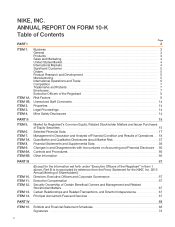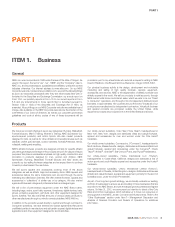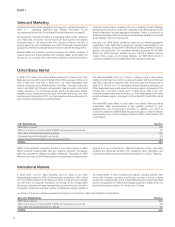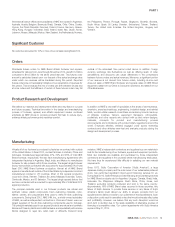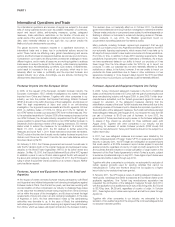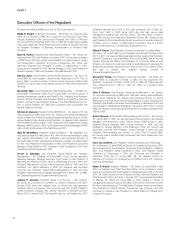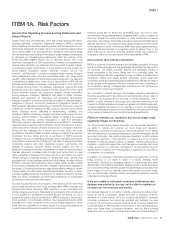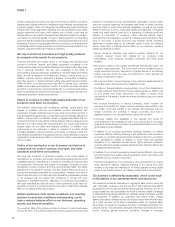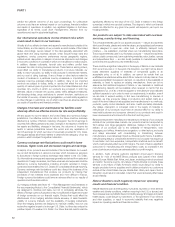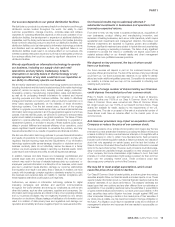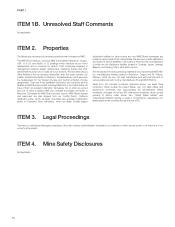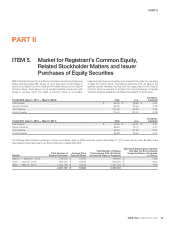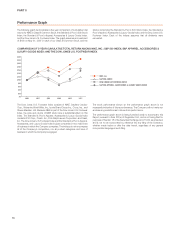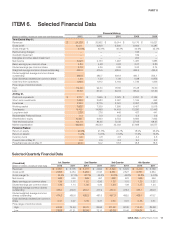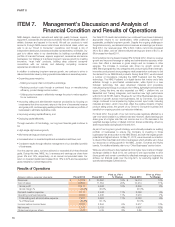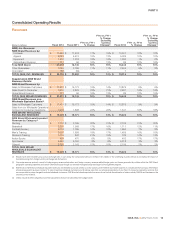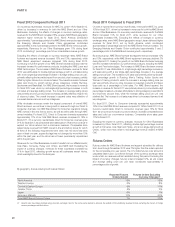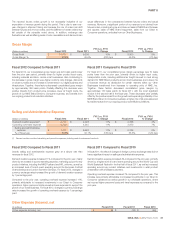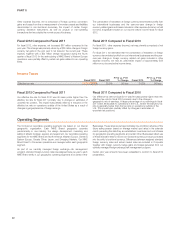Nike 2012 Annual Report Download - page 12
Download and view the complete annual report
Please find page 12 of the 2012 Nike annual report below. You can navigate through the pages in the report by either clicking on the pages listed below, or by using the keyword search tool below to find specific information within the annual report.PART I
predict the ultimate outcome of any such proceedings. An unfavorable
outcome could have an adverse impact on our business, financial condition
and results of operations. In addition, any significant litigation in the future,
regardless of its merits, could divert management’s attention from our
operations and result in substantial legal fees.
Our international operations involve inherent risks which
could result in harm to our business.
Virtually all of our athletic footwear and apparel is manufactured outside of the
United States, and the majority of our products are sold outside of the United
States. Accordingly, we are subject to the risks generally associated with
global trade and doing business abroad, which include foreign laws and
regulations, varying consumer preferences across geographic regions,
political unrest, disruptions or delays in cross-border shipments, and changes
in economic conditions in countries in which we manufacture or sell products.
In addition, disease outbreaks, terrorist acts and military conflict have
increased the risks of doing business abroad. These factors, among others,
could affect our ability to manufacture products or procure materials, our
ability to import products, our ability to sell products in international markets,
and our cost of doing business. If any of these or other factors make the
conduct of business in a particular country undesirable or impractical, our
business could be adversely affected. In addition, many of our imported
products are subject to duties, tariffs, or quotas that affect the cost and
quantity of various types of goods imported into the United States and other
countries. Any country in which our products are produced or sold may
eliminate, adjust or impose new quotas, duties, tariffs, safeguard measures,
anti-dumping duties, cargo restrictions to prevent terrorism, restrictions on
the transfer of currency, climate change legislation, product safety regulations
or other charges or restrictions, any of which could have an adverse effect on
our results of operations and financial condition.
Changes in tax laws and unanticipated tax liabilities could
adversely affect our effective income tax rate and profitability.
We are subject to income taxes in the United States and numerous foreign
jurisdictions. Our effective income tax rate in the future could be adversely
affected by a number of factors, including: changes in the mix of earnings in
countries with differing statutory tax rates, changes in the valuation of deferred
tax assets and liabilities, changes in tax laws, the outcome of income tax
audits in various jurisdictions around the world, and any repatriation of
non-US earnings for which we have not previously provided for U.S. taxes.
We regularly assess all of these matters to determine the adequacy of our tax
provision, which is subject to significant discretion.
Currency exchange rate fluctuations could result in lower
revenues, higher costs and decreased margins and earnings.
A majority of our products are sold outside of the United States. As a result,
we conduct transactions in various currencies, which increase our exposure
to fluctuations in foreign currency exchange rates relative to the U.S. Dollar.
Our international revenues and expenses generally are derived from sales and
operations in foreign currencies, and these revenues and expenses could be
affected by currency fluctuations, including amounts recorded in foreign
currencies and translated into U.S. Dollars for consolidated financial reporting.
Currency exchange rate fluctuations could also disrupt the business of the
independent manufacturers that produce our products by making their
purchases of raw materials more expensive and more difficult to finance.
Foreign currency fluctuations could have an adverse effect on our results of
operations and financial condition.
Our hedging activities (see Note 16 — Risk Management and Derivatives in
the accompanying Notes to the Consolidated Financial Statements), which
are designed to minimize and delay, but not to completely eliminate, the
effects of foreign currency fluctuations may not sufficiently mitigate the impact
of foreign currencies on our financial results. Factors that could affect the
effectiveness of our hedging activities include accuracy of sales forecasts,
volatility of currency markets, and the availability of hedging instruments.
Since the hedging activities are designed to minimize volatility, they not only
reduce the negative impact of a stronger U.S. Dollar, but they also reduce the
positive impact of a weaker U.S. Dollar. Our future financial results could be
significantly affected by the value of the U.S. Dollar in relation to the foreign
currencies in which we conduct business. The degree to which our financial
results are affected for any given time period will depend in part upon our
hedging activities.
Our products are subject to risks associated with overseas
sourcing, manufacturing, and financing.
The principal materials used in our apparel products — natural and synthetic
fabrics and threads, plastic and metal hardware, and specialized performance
fabrics designed to repel rain, retain heat, or efficiently transport body
moisture — are available in countries where our manufacturing takes place.
The principal materials used in our footwear products — natural and synthetic
rubber, plastic compounds, foam cushioning materials, nylon, leather, canvas
and polyurethane films — are also locally available to manufacturers. NIKE
contractors and suppliers buy raw materials in bulk.
There could be a significant disruption in the supply of fabrics or raw materials
from current sources or, in the event of a disruption, we might not be able to
locate alternative suppliers of materials of comparable quality at an
acceptable price, or at all. In addition, we cannot be certain that our
unaffiliated manufacturers will be able to fill our orders in a timely manner. If we
experience significant increases in demand, or reductions in the availability of
materials, or need to replace an existing manufacturer, there can be no
assurance that additional supplies of fabrics or raw materials or additional
manufacturing capacity will be available when required on terms that are
acceptable to us, or at all, or that any supplier or manufacturer would allocate
sufficient capacity to us in order to meet our requirements. In addition, even if
we are able to expand existing or find new manufacturing or sources of
materials, we may encounter delays in production and added costs as a
result of the time it takes to train suppliers and manufacturers in our methods,
products, quality control standards, and labor, health and safety standards.
Any delays, interruption or increased costs in the supply of materials or
manufacture of our products could have an adverse effect on our ability to
meet retail customer and consumer demand for our products and result in
lower revenues and net income both in the short and long-term.
Because independent manufacturers manufacture a majority of our products
outside of our principal sales markets, our products must be transported by
third parties over large geographic distances. Delays in the shipment or
delivery of our products due to the availability of transportation, work
stoppages, port strikes, infrastructure congestion, or other factors, and costs
and delays associated with consolidating or transitioning between
manufacturers, could adversely impact our financial performance. In addition,
manufacturing delays or unexpected demand for our products may require us
to use faster, but more expensive, transportation methods such as aircraft,
which could adversely affect our profit margins. The cost of fuel is a significant
component in manufacturing and transportation costs, so increases in the
price of petroleum products can adversely affect our profit margins.
In addition, Sojitz America performs significant import-export financing
services for most of the NIKE Brand products sold outside of the United
States, Europe, Middle East, Africa, and Japan, excluding products produced
and sold in the same country. Any failure of Sojitz America to provide these
services or any failure of Sojitz America’s banks could disrupt our ability to
acquire products from our suppliers and to deliver products to our customers
outside of the United States, Europe, Middle East, Africa, and Japan. Such a
disruption could result in cancelled orders that would adversely affect sales
and profitability.
Natural disasters could negatively impact our operating
results and financial condition.
Natural disasters such as earthquakes, hurricanes, tsunamis or other adverse
weather and climate conditions, whether occurring in the U.S. or abroad, and
the consequences and effects thereof, including energy shortages and public
health issues, could disrupt our operations, or the operations of our vendors
and other suppliers, or result in economic instability that may negatively
impact our operating results and financial condition.
12


